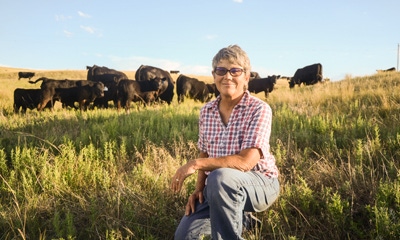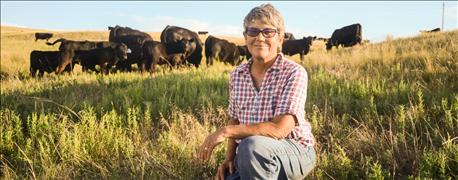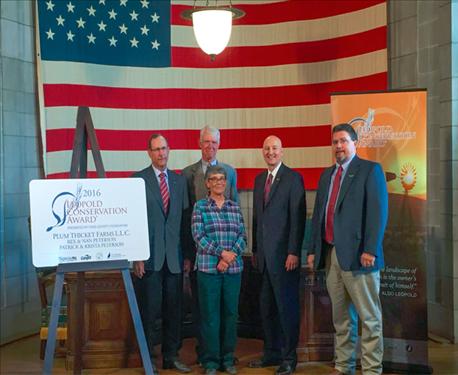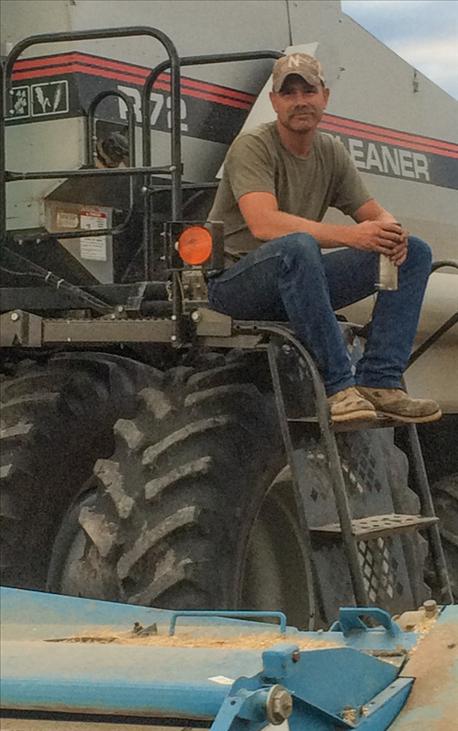August 26, 2016

If there's one word to describe Nancy Peterson's recordkeeping, it's meticulous. Nancy can tell you how many animal unit months (AUMs) were grazed and the stocking rate on certain pastures in a given grazing season, when cattle went onto a pasture and when they left, as well as how much precipitation the pasture received, and how much residual forage was left. She also keeps track of udder quality, mature weight, hip height, and calf performance all the way from birth weights to carcass data with multiple weights in between.

GIVE IT A REST: Nancy Peterson stands with a group of cows on one of her pastures near Gordon. In 2002, Nancy, husband Rex and son Patrick began using rest rotation grazing — giving about 25% of their pastures a season-long rest each year.
Nancy, a former practicing cow-calf veterinarian, along with her husband, Rex, and son Patrick, has managed Plum Thicket Farm since 1998. The family received the 2016 Nebraska Leopold Conservation Award.
When you're raising cow-calf pairs in a semi-arid environment on the northern edge of the Sandhills in Sheridan County, it pays to be meticulous.
"I will spend a long time, weeks, making up a grazing plan to make sure I'm not grazing a pasture at the same time I did the year before. Sometimes you switch things around because you have to make choices you'd rather not, but you have to because of circumstances," Nancy says. "You have to be willing to change your plan overnight. You have to be able to look at what your options are."
That's especially the case in drought years like 2002-07 and 2012.

LEADERS IN CONSERVATION: The Petersons were the 2016 recipients of the Nebraska Leopold Conservation Award. Pictured are Homer Buell (left), Sandhills rancher and 2012 recipient of the Nebraska Leopold Conservation Award; Rex and Nancy Peterson; Gov. Pete Ricketts; and Troy Stowater, 2016 Nebraska Cattlemen president-elect.
Adapting to extremes
Prior to a five-year drought in 2002, the Petersons began what's called a deferred rest rotation grazing program. This involves giving grazing pastures a season-long rest. "If you're in a continuous grazing situation in drought, you have to put wheels under the cattle or have enough feed to make up for things," Rex says. This way, they were able to go into the 2002-2007 drought without decreasing stocking rate. "It worked well enough that there was very little degradation of pasture in those five years. That made us a believer."
After that, they put all their pastures into the rest rotation. Now, they give about 25% of their pastures a rest each year so that every pasture gets a break every four years.
Meanwhile, all perennial pastures are grazed for a maximum length of a month before cattle are moved, before coming back to that pasture later in the fall when grass is dormant. They also try to never graze the same pasture at the same time of year two years in a row.
Depending on the year, they try to remove 0.7 AUM (the amount of forage removed by a 1,000-pound animal unit in a given month) per acre on perennial warm-season pastures, which include switchgrass, prairie sand reed and sand bluestem. During drought years, they often bring this down to 0.4 AUM.

PASSION FOR SOIL HEALTH: Patrick Peterson (pictured), Rex and Nancy's son, manages the cropping rotation at Plum Thicket Farm.
And annual cover crops are one way to cut back on the amount of time spent on pasture. About 11 years ago, Patrick began no-tilling on the 2,300 acres of crops at Plum Thicket, and in 2013, they began incorporating cover crops for forage in their dryland and irrigated rotations.
"Grazing cattle also gives us more cropping options," says Patrick. "Right now, there's not a single cash crop I could plant that would actually pencil out. Like a lot of farmers, we're trying to manage loss. These forage crops usually cost about half as much as cash crops to plant, and we lose a lot less in some cases."
They use cereal rye to calve on in April and May before planting corn or soybeans on the field. And they also grow a variety of spring and summer mixtures for forage. As long as there's water available, spring cover crop blends provide an average of 2.4 AUMs per acre, while a summer mix will average around 1.68 AUMs per acre.
Grazing cover crops also gives perennial forages a chance to rest. By grazing cover crops in 2013, they were able to keep cattle off pastures until the middle of August. "That made it so by 2015 we're back up to full production," Rex adds. "Grazing annuals makes it so we can do more deferred and rested pastures. The result is that even during a drought, you can watch switchgrass and sand reed and sand bluestem come into your pasture where you had a hard time finding them before."
Drought on the horizon
The next drought may be right around the corner. This year, the ranch has received 11.5 inches of rainfall, compared to last year's 25 inches and an annual average of 16. Meanwhile, Nancy's latest range measurements show an average stubble height of 16 inches, compared to last year's 27 inches. "We are already experiencing drought here," she says. "I've already spent several days at my computer thinking about how I'm going to feed cattle and making rations based on the feed I have."
As a detailed record-keeper, Nancy keeps track of older cows, cows with lower udder quality, and those that aren't performing up to par to sell in the fall, reducing the pressure on the forage resource.
However, she adds the goal is to avoid selling more cows than they have to. Should the need arise, they have a drylot available for cows, and thanks to their crop rotation and irrigation, they have a readily-available supply of corn silage and oat-pea silage, in addition to cover crops to graze.
Because of the way the Petersons have managed Plum Thicket, they're going into 2017 in good shape. No-till and cover crops have helped improve infiltration and protect ground from erosion, making the land better able to handle extreme weather events like drought. Rest rotations have given pastures more time to recover after grazing, meaning more residual to catch snow and a deeper root system to find soil moisture during drought.
"Fortunately, because of the way we've managed, we've got a really healthy root system and healthy soil," Nancy says. "I'm not going to take as much grass off my pastures as I normally do in 2017, but I'm comfortable that we're going into this OK."
You May Also Like




